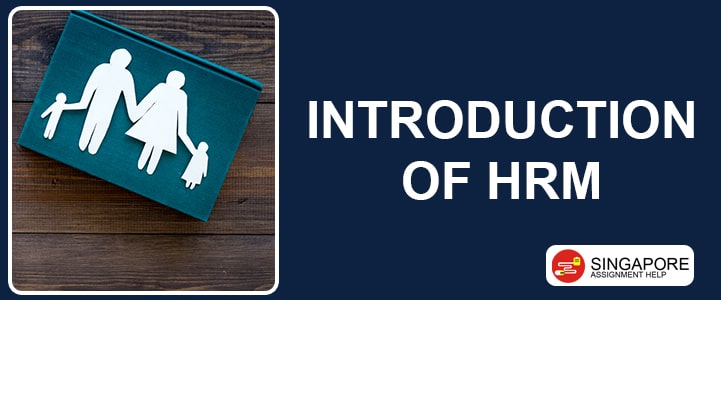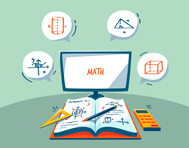Introduction Of HRM (Human Resource Management ) - Detailed Explanation
The content is for students who are pursuing a Management or MBA degree or Diploma from Singapore University and have to study Human resource introduction, Singapore is known for its management studies and universities like Monash stand in the top 100 universities in education.
This content may help students of Monash or other Universities of Singapore. Here our expert assignment writers are giving you a brief about what is HRM with a simple definition. This is an in-depth guide prepared by Human resource management assignment writers

Human resources management (HRM) is a management function concerned with hiring, encouraging and sustaining people in an organization. It focuses on persons in organizations. Human resource management is scheming management systems to safeguard that human talent is used efficiently and proficiently to achieve organizational goals.
HRM is the employees’ function which is concerned with procurement, progress, reward, integration, and maintenance of the personnel of an organization for the purpose of contributing towards the accomplishments of the organization‘s objectives. Therefore, personnel management is the planning, organizing, directing, and controlling the performance of those operative functions.
HR Practice and Company Performance
HRM supports a company to achieve its objective from time to time by creating a positive attitude among workers. Reducing wastage and making maximum use of resources etc. Due to proper HR practices, workers are skilled well and this makes them ready for future raises. Their capacity can be employed not only in the company in which they are presently working but also in other companies which workers may join in the future.
Healthy HRM practices can comfort the organization to maintain a co-ordinal relationship with the unions. Efficient HR practices teach individuals to work in a team and making adjustments to improve efficiency. After constant training, the company is also able to identify potential employees who can be promoted in the future for top-level jobs. HRM increases the performance of the company by recruiting the right people.
Buy high-quality essays & assignment writing as per particular university, high school or college by Singapore Writers
Goals of HRM
The goal is to make strategic planning for the organization so it may increase effectiveness. The main goals are:
- a) The attainment of the organization’s goals and objectives,
- b) Financial profitability,
- c) Positioning to create advantages for the short-term and long-term, and
- d) To create a sense of social responsibility.
Characteristics of HRM
- HRM involves management functions like planning, organizing, directing and controlling
- As it is management driven so involves procurement, development, maintenance of human resource
- It helps to achieve individual, organizational and social objectives so
- HRM is a mighty disciplinary subject. It includes the study of management psychology communication, economics, and sociology.
- It involves team spirit and teamwork.
- It develops and maintains the quality of work-life
- It believes that people should be treated as assets (human capital)
Theoretical Perspective to understand what is HRM
According to the behavioral view the favorable and appropriate concepts, techniques are used to improve the behavior to achieve objectives
The resource-based theory of HRM draws attention to the strategic value of the workforce and to the issues of workplace learning. Thus, it appears to embrace a soft view of HRM.
The political view of the theory of HRM manage their human resources according to recurrent trends and changes in socio, economic political situations
Hard HRM and Soft HRM
The hard model is based on ideas of i) tight strategic control, and ii) an economic model of man,.On the other hand, the soft model is based on i) managing human resource through commitment and ii) through cohesion. The hard model belongs to the traditional view of management and it aims to make a regulator environment in the workplace by constricted rules and regulations, order, authority, strict supervision, etc The hard model reflect human resource as an economic resource or commodity or like new technology.
Henceforth, the performances or out-put are expected through using tight regulator policies like rules, regulations, more supervision and disciplinary actions, etc. While Soft model aims to make an encouraging and potential work environment that persuades people/human resources to work efficiently. In this model, people or workers are encouraged to work. Commitment and contribution are highly expected in the workplace within this model.
Naturally, people tend to work and behave without any supervisory order or authority, knack or force within this model. The soft model sees employees as valued assets and as a basis of competitive advantage through their commitment, adaptability and high level of skills and performance. The three key features of soft HRM model are, first various forms of flexibility; second-team building, empowerment, involvement and the third, culture management.
Hire a Professional Essay & Assignment Writer for completing your Academic Assessments
Native Singapore Writers Team
- 100% Plagiarism-Free Essay
- Highest Satisfaction Rate
- Free Revision
- On-Time Delivery
Best Fit / Contingency Model:
“HR policies become well-organized when it is linked to its adjacent context or environment of the business. There are two elements in this model:
- External Fit – the fit is linked to process strategy/marketing strategy etc. that is, the competitive policy of the overall business. It talks about the connection between competitive advantage, employee behaviors and practices.
- Internal Fit – HR policies and practices must be comprehensible. Policies that work in the opposite direction should be avoided. For example, inspiring teamwork but rewarding teamwork
This theory is about to attain the best ” fit” between what the organization is and wants, technology, size, structure, the people, its employees and its outside environment and what the organization achieves and how it is structured and the processes, procedures, and practices it implements. It suggests a situational viewpoint that enables any organization to face any challenging circumstances and opportunities.
In this theory, it is supposed that there is no collectively accepted practice or principles in managing human resources. It is a contrasting viewpoint to universalistic theory. According to this managers are supposed to act according to environmental factors both internal and external to the organization.
Therefore the advocates of this theory are classified as contingents or situation lists and their philosophy as ‘best fit theory or contingency theory of HRM. The Underlying philosophy of the theory is the complicated relationship that exists between the alteration and the durability and it is an admixture of both.
Harvard Analytical Framework for HRM.
Most of the later theories in HRM were propounded on using certain elements of this Harvard Analytical Framework. Consequently, it could be well-thought-out as the brainchild of other models and theories of HRM. The basics in later theories like investor interests, the internal and external environments, policy choices, vision and strategies, certain soft views are rooted in this Analytical Framework. This idea transports us to a team approach. The main qualities and characteristics of Harvard Analytic Framework are
- Bears stakeholder perception
- Shared cooperation and commitment
- As an alternative supervisory style, seeing HRM an employee influence
Therefore, this model is composed of elements like mutual respect, mutual commitment, mutual obligation and it depends on teamwork spirit and certain elements in soft view of HRM. Harvard Analytic Framework is the descriptive theory of HRM which originates the wholesome coverage of HRM functions or their essentials. Harvard Analytic Framework seems to be similar to HRM functions as micro-minute forces, emphasizing the usefulness and interrelationships.
Features of Harvard
- It identifies a wide range of stakeholder interests and related factors that influence HRM
- HR policy choices result in outcomes of organizational obligation, competence & cost-effectiveness and, in turn, have long term consequences for individuals, enterprise and society.
- HRM is integrated with general, line management. There is still a role for HR experts, while all managers are seen as responsible for HRM.
- The main focus is the enterprise, or firm, as the unit of analysis
- People are viewed as social capital. HRM is seen as an investment in human capital
- A mutual fit between organizational policy and human resource strategy is seen as vital. The top-level of management integrates HR policy and strategy
Resource-based Principle of HRM
The resource-based opinion of HRM explores the ways in which an organization’s human resources can deliver a sustainable competitive gain. It can be best explained by the VRIO framework:
- Value
- Rarity
- Inimitability
- Organization
- Value
This principle supports the ensuring the potential value of outputs is maximized and that they fully meet the needs of the customers for whom the product or service is intended organizations requirement to consider how the human resources function can generate value; it is quite common in organizations to reduce costs through HR such as the lessening in headcount and the introduction of flexible working practices etc., but it is also important to consider how they might increase revenue.
The suggestion of the resource-based view is that if Human Resources desires to be a ‘strategic partner’, they need to know which human resources contribute the most to supportable competitive advantage in the business, as some human resources may provide greater influence for competitive advantage than others. It explores how an organization’s resources can provide a sustainable competitive advantage by focusing on promoting sustained competitive advantage via developing human capital.
It is also concerned with the relationships between internal (HR) resources, strategy, and firm performance. HR can provide a competitive advantage if they are unique and cannot be replicated. Overall this emphasizes not only on behavior but also on skills, knowledge, attitudes, and competencies
Stuck with a lot of homework assignments and feeling stressed ? Take professional academic assistance & Get 100% Plagiarism free papers
Michigan Model
Michigan model ensures ways to achieve the organizational objectives is the application of five major functions of HRM very effectively. According to this model, this process is totally dependent on the HRD policies and programs of the organization.
It is believed that the whole of HRM is a recurring process in which every function is symbiotic hence the value of each function is very identical for acceding the organizational objectives. The work and contribution of properly selected human resource has to be evaluated in using appropriate techniques.
Some kinds of rewards have to be obtainable on the basis of results of an appraisal and the performances of employees. In this model, it tries to encapsulate all key functions of HRM and to utilize it in a more comprehensive manner. Therefore, the underlined ideology of this model could be termed as a descriptive theory of HRM
Guest Model
According to Guest'” HRM theory has three categories like strategic theory, descriptive theory, and normative theory. This model belongs to strategic theory must have two important viewpoints viz. assimilation and accommodation.
Assimilation implies the organization attains experiences from both internal and external environments and in the process, it should formulate probable strategies. Conversely, in accommodation, the organization should apply those strategies and its environment undergoes change as per the demands of the model.
Mostly views and ideas of contingency theory have some traditionalism with the strategic theory. As the descriptive theory describes HRM more inclusively by classifying the whole content of HRM functions. In this theory, the whole HRM process is considered as one element and the proponents assume that every aspect such as aims, objectives, vision, missions, policies and procedures, stakeholders, etc belong to the organization as ingredients for achieving the desired objectives.
Warwick Model
This model was developed by two researchers, Hendry and Pettigrew of the University of Warwick (hence the name Warwick model). Similar to other models, the Warwick proposition centers around five elements
- Outer Context (macro-environmental forces)
- Inner Context (firm-specific or microenvironmental forces)
- Business Strategy Content
- HRM Context
- HRM Content
This model takes cognizance of business strategy and HR practices (as the Guest Model), the external and internal context (unlike the Guest Model), in which these activities take place and the process by which such changes take place, counting interactions between changes in both context and content.
The strength of the model is that it identifies and classifies important environmental influences on HRM. It plots the connection between the external and environmental factors and explores how HRM adapts to changes in the context. Apparently, those organizations achieving alignment between the external and internal contexts will achieve performance and growth.
Storey Model
Storey distinguished between the hard and soft HRM management system. He suggested that the management of a Hard HRM system is based on obtaining value by managing the people in a strategic way in order to have competitive advantages.
According to this model, the employees and the human resources who are working in an individual manner or collective manner have been suggested as the valued assets. It defined the HRM system as a coherent approach in managing these assets. This version of HRM has been concentrating on measurable criteria, control, and qualitative performance management. Storey also recommended that the soft HRM has been focusing on the employees as valued assets.
The adaptableness, higher quality, the commitment of the employees is the main concern in this version. Storeyspecified that the personnel management is to manage the employees in complying with rules as per the requirement of the owners of the business. Payrolls, employment laws, etc are mainly focused on personnel management. It can be thought of as a bureaucratic approach in strategic human resource management.
Ulrich Business Partner Model
The model is well known for introducing mainly the aspects of Human Resources with the highest value-added. Ulrich is considered a pioneer in HR. He defined the most common HR Roles model, which generally used in the market.
The main contribution of David Ulrich’s HR Model was to start the movement from the functional HR orientation to the more partnership organization in HRM Function. Business Partnering is not possible to implement without a foremost shift in the HR Organization.
The benefit was a more responsible and flexible organization of Human Resources, which allowed many HR Professionals to become real respected business partners.
The HR Model defined by Ulrich brings for the main criteria:
- strategic partner
- change agent
- employee champion
- administrative expert
Strategic Partner is about the alignment of HR activities and initiatives with the global business strategy and it is the task of the HR Management and HR Business Partners.
Change Agent is a very important area of this model. It is about supporting the change and transition of the business in the area of the human capital in the organization. The role of Human Resources is the support for change activities in the change effort area and ensuring the capacity for the changes.
Administrative Expert changes over the period of time. In the beginning, it was just about ensuring the maximum possible quality of delivered services, but nowadays the stress is put on the possibility to provide quality service at the lowest possible costs to the organization.
Employee Champion is a very important role in Human Resources. The employee advocate knows what employees need and HRM should know it.
HRM and Organizational Effectiveness
It concerns how an organization will compete, and how would an organization be able to assess the effectiveness of its strategic plan. Indicators of effectively-crafted strategic plans include creating advantages that are sustainable over a long period of time.
To find the effectiveness the plan organization should know
- a) The attainment of the organization’s goals and objectives,
- b) Financial profitability,
- c) Positioning to create advantages for the short-term and long-term, and
- d) Creating a sense of social responsibility.
Challenges in the Future
As the business environment is rapidly changing therefore the need to update knowledge and skills by looking at the organization‘s needs and objectives is increasing.
The important challenges for HR in the future in a dynamic global environment are
- Managing the Vision
- Creating a conducive environment
- Changing Industrial Relations and managing relationships of employer and employees
- Building Organizational Capability
- Understanding the Job Design and Organization Structure in changing and demanding global scenario.
How we can help you in making HRM Assignments & Projects
HRM principally deals with manpower for an organization. If you are also a student of HRM and concerned about the assignments making then you can consult with our assignment writers and take paid assignment writing services by management experts.
Native Writers from Singapore may also assist you with essay writing, PPT creation or any other format of assignments. These are some sub-branches of HRM in which experts are available;
1. Recruitment, e-recruitment
2. Training & Development
3. Employee Engagement and placements process
4. Performance Management
5. Compensation & Benefits
6. Back office Processing
7. Professional associations
8. Compensation and benefits managers.
9. Human resources information system (HRIS) analysts.
10. Employee assistance plan managers.
11. Labor relations
Hire a Professional Essay & Assignment Writer for completing your Academic Assessments
Native Singapore Writers Team
- 100% Plagiarism-Free Essay
- Highest Satisfaction Rate
- Free Revision
- On-Time Delivery











